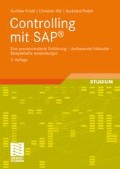Auszug
Dieses Kapitel erläutert die Grundlagen von SAP R/3. Es zeigt, wie die Kosten- und Erlösrechnung in SAP R/3 abgebildet wird, und beschreibt die Grundstruktur des Moduls Controlling (CO). Erste Hinweise zum Arbeiten am System runden das Kapitel ab.
Access this chapter
Tax calculation will be finalised at checkout
Purchases are for personal use only
Preview
Unable to display preview. Download preview PDF.
Literatur
Vgl. ausführlich SAP AG (2005a), S. 14.
Vgl. SAP AG (2005a), S. 16.
Vgl. SAP AG (2005a).
Vgl. SAP AG (2005b).
Vgl. SAP AG (2003b).
Vgl. SAP AG (2002b).
Vgl. SAP AG (2003c)
Vgl. SAP AG (2003d)
Gadatsch (2001a), S. 403, wählt eine Einteilung in Büro-Applikationen, Business-Applikationen und Kommunikations-Applikationen.
In Anlehnung an Mertens et al. (1996), S. 10.
Vgl. Mertens (1997), S. 1ff.
Vgl. auch Gadatsch (2001a), S. 402.
Vgl. SAP AG (2004).
Vgl. Krcmar (2005), S. 110.
Wichtig: Durch das Customizing werden nicht die R/3-Standardprogramme modifiziert, sondern es wird die Möglichkeit gegeben, in entsprechenden Tabellen die Rahmenbedingungen für den R/3-Benutzer vorzugeben (z. B. Vorgabe eines bestimmten Kalkulationsschemas). Zu Funktionen des Customizing vgl. Baumeister (1999), S. 8f. Vgl. auch Brehm/Heinzl/Markus (2001).
Vgl. hierzu und zum Folgenden: Stahlknecht/ Hasenkamp (1999), S. 146f.
Vgl. SAP AG (2005b).
Vgl. hierzu und zum folgenden SAP AG (2005b).
Vgl. ausführlich SAP AG (2005b), S. 7.
Vgl. z. B. Schweitzer/ Küpper (2003), S. 46ff.
Vgl. Schweitzer/ Küpper (2003), S. 49f.
Vgl. Schweitzer/ Küpper (2003), S. 155.
Vgl. Schweitzer/ Küpper (2003), S. 80.
Abbildung entnommen aus Schweitzer/ Küpper (2003), S. 526.
In Anlehnung an SAP AG (1999a), S. 1–9.
Vgl. hierzu und zum Folgenden Wenzel (1997), S. 68.
Vgl. hierzu und zum Folgenden Wenzel (1997), S. 69ff.
Rights and permissions
Copyright information
© 2008 Friedr. Vieweg & Sohn Verlag | GWV Fachverlage GmbH, Wiesbaden
About this chapter
Cite this chapter
(2008). Grundlagen von SAP R/3. In: Controlling mit SAP®. Vieweg+Teubner. https://doi.org/10.1007/978-3-8348-9238-6_1
Download citation
DOI: https://doi.org/10.1007/978-3-8348-9238-6_1
Publisher Name: Vieweg+Teubner
Print ISBN: 978-3-8348-0419-8
Online ISBN: 978-3-8348-9238-6
eBook Packages: Computer Science and Engineering (German Language)

